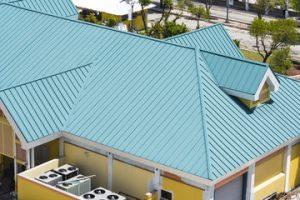Professional roofing contractors follow manufacturer guidelines and local building codes to ensure the longevity and effectiveness of your new roof. A thorough inspection of the work area prevents problems before they occur.

Accurate roof measurements allow for the installation of panels that fit the dimensions of your home, minimizing material waste. Metal trim is installed along the eaves, and flashing helps seal areas around vents, chimneys, and joints. Visit their Website to learn more.
The roof of a house is one of its most critical components for a number of reasons. It protects the structure from the elements, keeps residents comfortable and safe inside, and contributes to a home’s aesthetic. As a result, it’s important to consider a variety of roofing materials when choosing a roof for your home. There are numerous options available to homeowners including asphalt shingles, metal roofs, clay tiles and more. Each type of roofing material offers a different function, durability and aesthetic appeal.
The choice of the right roofing material depends on many factors, including the climate where your home is located and your budget. A durable roof should be able to withstand heavy rains and snowfall and stand up to high winds. Other considerations include fire resistance and energy efficiency. In addition, the roof should be aesthetically appealing and suit your property’s style.
Roof sheathing is the wooden boards that provide the foundation for a roofing system, ensuring that shingles are held securely in place and protected against water leaks. Plywood and oriented strand board (OSB) are common forms of sheathing for homes, but other materials like exterior gypsum board and concrete sheathing are also used in specific applications and projects. Sheet sheathing is favored in modern construction due to its uniformity, ease of installation and superior strength compared to traditional plank sheathing.
Asphalt shingles are a popular roof option for their low cost, versatility and wide range of colors, finishes and styles. They can be designed to resemble wood, slate and even clay tiles. Some types of shingles are made to withstand wind speeds up to 120 mph, while others are more resistant to hail damage and ongoing freeze-thaw cycles.
Clay tiles are an attractive, durable roof option that evokes a rustic charm and adds value to the home. They’re also a great energy-efficient roof since their cellular design helps keep heat in during the winter and cool air out in the summer.
A metal roof can be a highly durable and attractive roof for your home. They’re available in a variety of color, finish, and style options and can add to the curb appeal of your home. Metal roofs can withstand high wind speeds, ice and hail impact. Some have a warranty against corrosion, rust and rot for up to 50 years.
Preparation
Before the first shingle goes up, the roofing contractor will take the time to prepare the property. This includes clearing the area around the roof, covering vehicles and outdoor furniture, and protecting delicate items inside from vibrations and dust. It also involves informing neighbors about the upcoming work, which is courteous and reduces confusion and misunderstandings about noise and commotion.
Roofing materials and supplies are ordered and delivered to the job site. Depending on the size of the roof and the roofing material chosen, the roofer may need to rent specialized equipment like ladders or a forklift. They’ll also need to bring standard tools and materials like hammers, nailers, roof rakes, ice scrapers, and hard hats. The roof deck is then cleaned and prepped to receive underlayment, shingles, and flashing. The underlayment and shingles are installed with proper alignment, positioning, and nailing techniques to ensure weather resistance and a durable look. Flashing is installed in roof valleys, along chimneys and vents, and to protect the ridge of the roof. Proper cutting and sealing of these elements is essential to prevent leaks.
Finally, a ridge cap is added to the top of the roof to finish it and protect it from the elements. It’s important to choose a high-quality ridge cap to keep out rain, hail, and snow and to add curb appeal to the property.
Once the roof is complete, a final inspection is conducted by the roofing contractor to ensure that all installation procedures were followed and that the roof meets industry standards, manufacturer specifications, and local building codes. The inspector will check for proper shingle alignment, secure installation of flashing and sealant, ventilation, and insulation to make sure that the new roof is built to last and properly protects the property.
This thorough and thoughtful process sets the stage for a durable, beautiful roof that keeps the home or commercial property protected for years to come. The homeowner can then enjoy their new roof with peace of mind knowing that a professional roofing contractor has done the job right. The contractor will provide a warranty on the work and offer maintenance tips to help the new roof perform at its best.
Installation
A professional roof installation provides homeowners with a new, durable, and attractive roofing system that protects their homes and belongings from weather elements. It also enhances the home’s appearance, energy efficiency, and structural integrity. A quality roofing installation requires careful planning and execution to achieve optimal results.
During the installation process, homeowners will receive regular updates from their contractors on project progress. They may also be asked to provide feedback to ensure they’re satisfied with the work being performed. A contractor will also explain any additional services or products they offer, including maintenance plans and financing options.
Before the actual roof installation begins, the old roofing materials must be removed. This is a messy process that involves scraping and tearing off shingles, panels, and any other outdated roofing materials. The debris is then discarded in a dumpster or other containers for safe disposal.
Once the old roof is removed, the new materials can be delivered and installed. Depending on the type of roof, this may require several days to complete. It is best to schedule this work during the winter or early spring to avoid inclement weather and minimize any potential delays.
The installation of the shingles or tiles is usually done in overlapping rows, starting at the bottom edge and moving upwards towards the peak. This method is critical for proper water runoff, and it helps prevent rainwater from seeping underneath the shingles or tiles. Fasteners are then applied consistently to secure the materials. A professional roofing contractor will pay close attention to detail during this phase, ensuring that the shingles or tiles are properly aligned and secured.
Upon completion, the roofing contractor will conduct a comprehensive final inspection to verify that the roof meets industry standards and manufacturer specifications. They will check for proper shingle or tile alignment, secure flashing, and adequate ventilation to ensure long-term performance. They will also inspect the gutters and downspouts to ensure they are free of obstructions and debris.
After the inspection, the roofing contractor will conduct a thorough cleanup to leave the work area in better condition than before they began. They will remove the tarps and plywood from the property, sweep the area, and use a magnet to make sure there are no lingering nails or metal debris. This is important for the safety of residents and their pets, and it ensures that the contractor leaves the work site in pristine condition.

